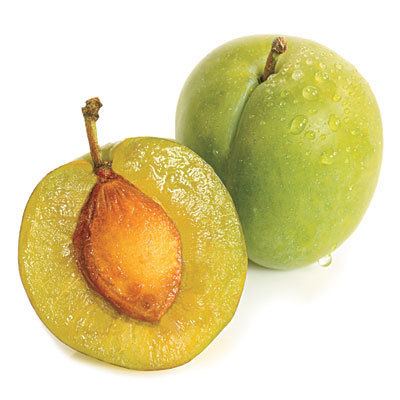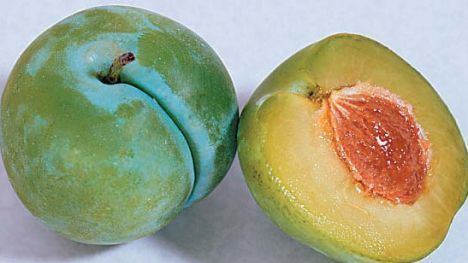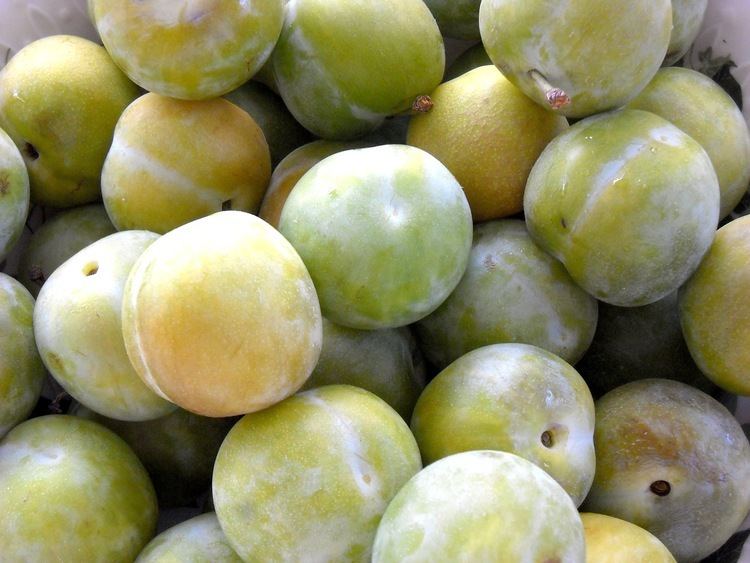Genus Prunus Section Prunus Rank Subspecies | ||
 | ||
Similar Damson, Common plum, Cherry plum, Sugar, Plum | ||
Greengage plums
The greengages are a group of cultivars of the common European plum. The first true greengage was bred in Moissac, France, from a green-fruited wild plum ('Canerik') originally found in Asia Minor; that original greengage cultivar nowadays survives in an almost unchanged form as the cultivar 'Reine Claude Verte'.
Contents
- Greengage plums
- Pruning 3rd year greengage plum tree
- Description
- History and etymology
- Cultivation
- References

The Oxford English Dictionary regards "gage" and "greengage" as Synonyms. However, not all gages are green, and some horticulturists make a distinction between the two words, with greengages as a variety of the gages, scientifically named Prunus domestica subsp. italica var. claudiana. The gages (P. d. ssp. italica) otherwise include the large and usually purple to blackish but occasionally bright yellow round plums (var. subrotunda, e.g. the Ontario plum), as well as the ancient and little-known Austrian varieties Punze (var. rotunda) and Weinkriech (var. vinaria).

Pruning 3rd year greengage plum tree
Description

Greengage fruit are identified by their round-oval shape and smooth-textured, pale green flesh; they are on average smaller than round plums but larger than mirabelle plums (usually between 2 and 4 cm diameter). The skin ranges in colour from green to yellowish, with a pale blue "blush" in some cultivars; a few Reine Claudes – such as 'Graf Althanns' – are reddish-purple due to crossbreeding with other plums. Greengages are grown in temperate areas and are known for the rich, confectionery flavour. They are considered to be among the finest dessert plums.
History and etymology
Greengage fruit originated in the Middle East. "Green Gages" were imported into England from France in 1724 by Sir William Gage, 7th Baronet, from whom they get their English name. Allegedly, the labels identifying the French plum trees were lost in transit to Gage's home at Hengrave Hall, near Bury St. Edmunds. Soon after, greengages were cultivated in the American colonies, even being grown on the plantations of American presidents George Washington (1732–1799) and Thomas Jefferson (1743–1826). However, their cultivation in North America has declined significantly since the 18th century.
The name Reine Claude (French for "Queen Claude"), by which they are known in France, is in honour of the French queen Claude (1499–1524), Duchess of Brittany. Greengages are also called la bonne reine (French for "the good Queen") in France.
Cultivation
Greengages are widely grown in particular in western Europe. The core of their range extends from France to southern England. In Germany, where they are called Reneklode or Ringlotte, numerous cultivars have been developed too. In Poland and the Czech Republic, they are known as ringle, in Hungary as ringló, and in Slovakia as ringloty. They are widely grown, typically for stewing in syrup to make a compote.
At least the green cultivars breed more or less true from seed. Several similar cultivars produced from seedlings are now available; some of these include other plum cultivars in their parentage. Widely grown cultivars include:
